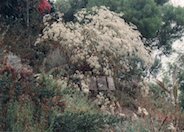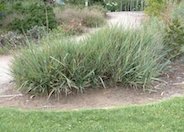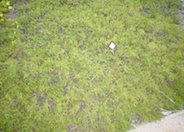
Common name:St. Catherine's Lace
Botanical name:Eriogonum giganteum
St. Catherine's Lace is a large open shrub growing 4'-5' high and 3'-4' wide with woolly, gray leaves and flat clusters of cream flowers that turn rust with age. It is a CA native that is drought tolerant. It attracts butterflies and beneficial insects. - Cornflower Farms

Common name:Canyon Prince Wild Rye
Botanical name:Leymus condensatus 'Canyon Prince'
One of the best known and utilized native grass selections in Southern California, this beautiful, blue gray foliage spreads out 3'-4' or more. It will reach a height of 2'-3'. It rarely flowers. It does spread by rhizomes although not as vigorously as some closely related species. It can be extremely drought tolerant and care must be taken not to over water this species as it can rot from the center. Otherwise, it is carefree and requires virtually no maintenance.

Common name:Dwarf Coyote Brush or Chaparral Bro
Botanical name:Baccharis piluraris 'Twin Peaks'
Complete with a strong, dense root system which clings attractively to slopes, this makes for an excellent low maintenance ground cover. In addition, it has no messy seeds.

Common name:California Fuchsia, Zauschneria
Botanical name:Epilobium canum
The California fuchsia is a perennial with dense, narrow, green gray foliage and red orange summer flowers. The growth habit of this plant is sprawling and low. The California fuchsia is native to California, is drought tolerant, and attracts hummingbirds. -Cornflower Farms
| Designer: Vickie Absey | Valley Garden 9 |
Photographer: GardenSoft |
Soils and Compost:
Maintain a two to four inch layer of mulch on the soil surface to reduce weeds, infiltrate rain water, and reduce compaction.
Water Saving Tip:
Integrated Pest Management:
Drip and other smart irrigation delivers water directly to roots, allowing no excess water for weeds.
